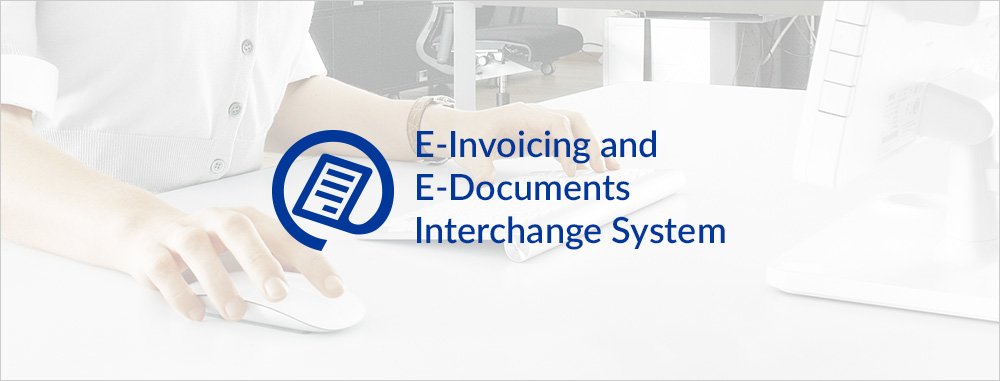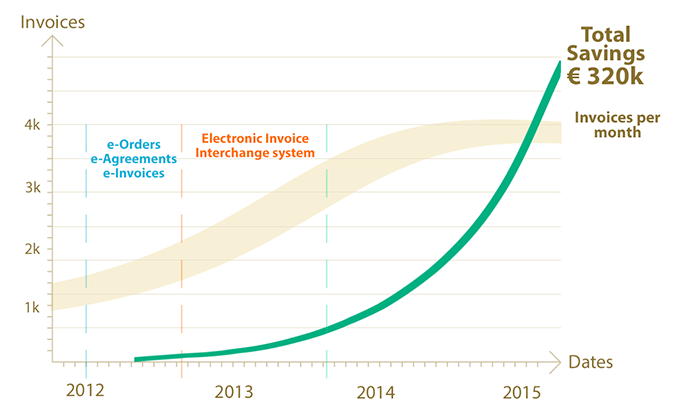e-Invoicing and e-Documents Interchange System: Is It Good for Midsize Business?

Four years ago we made a huge step forward and launched an electronic invoice interchange system (e-Invoicing), the system of control over operations and documents (e-Documents) and automatic interaction with accounting systems.
Arthur Karbone and Dmitry Smirnov are the leaders of our Software Development team that specialize in the sphere of electronic document flow and e-invoices. The interview with Artur and Dmitry is recorded by Darja, Marketing Manager.
Artur, what positive or negative experience could you share with us?
First of all, thank you for the possibility to talk about that project, Darja. In 2011 we launched quite a big computerized application. This system has replaced a whole spectrum of programs in Access, Excel, Delphi and so on. It was a big step forward. We got rid of several hundreds of man-hours of half-manual labour connected with the execution of applications for cargo transportation, issuing invoices and accounting of a company. In 2013 we launched the electronic invoice interchange system. Some of the key features are:
- get thousands of invoices by e-mail and link the invoices to clients and orders;
- send invoices by web services, emails and exchange the data in EDI format;
- check the invoices both for the corresponding transportations and services, as well as for taxes;
- notify clients about the problems or data discrepancies, and help operators to solve difficult financial problems while processing the invoices.
All this certainly is a positive experience. We have reduced the number of errors connected with human factor; we have accelerated and optimized the work of financial and production department.
And negative effect?
To our satisfaction, I cannot say anything about the negative conclusions. E-Invoices and e-Documents – are right and effective. We do not have any lost documents anymore, no missing invoices. Our customer’s reputation was always high standing and corresponded to the European quality standards, but since the e-Invoices and e-Documents system was introduced, it helped to step up on the next level and get new business sector.

Savings for midsize business because of the implementation of e-Invoicing and e-Documents interchange system.
For companies that still consider whether to use the e-Invoicing system or not, the main question is about safety and risks. As the other part – the main advantage of e-Invoices is the better order and reliability about the invoice processing. Could you, please, comment on this development paradox?
Modern technological solutions allow achieving maximum reliability and minimizing risks. To a large extent, these criteria pale into insignificance, while the most important criteria of choice is the possibility of integration with the existing solutions and business environment.
The daily work of several specialists connected with risk to omit the amounts, make a mistake, print and scan a wrong document, was significantly simplified and ranked. However, there is a concern that after the introduction of the electronic document exchange and e-Invoicing system the necessity in human resources will diminish. How did the introduction of e-Invoices and e-Documents affect the psychological atmosphere at your customer’s company?
The implementation of this project was formulated in the long-term strategy of the company. As a result, the efficiency coefficient of each employee was significantly improved; at the same time, the number of mistakes was reduced.
As a result of growth, the company avoided psychological suspense and in some cases could avoid hiring new employees, and continue to raise the effectiveness of the existing personnel. Moreover, the staff admitted that because of innovations, their work has become more comfortable, they have also avoided the problems that arose while manually processing the paper copies of invoices.
Everything is developed in a way that the user gets the prepared information that is the most effective to work with. How do you automatically check information received from customers?
There is a regular situation when some numbers in invoice received by email or web do not correspond with the expected ones. The system is developed to reduce the manual labor as much as possible. We know what kind of Invoice we expect, our engine parses the information in electronic Invoice and match with our expectations.
On the other part, we use business-accepted standards. This allows us to solve a range of problems of interaction between essentially different technical implementations.
Nowadays, international standards already exist (for example, http://www.unece.org/trade/untdid/welcome.html) and are widely used and allow to avoid a whole spectrum of communication problems between electronic systems. As a result, the solution to the problem mentioned above is about to check if the received data correspond to the standard.
Are your team planning to use Cloud services and open SAAS there?
Many of our closest partners would like to have the same or similar system. Transfer to cloud service and monetization of our product is around the corner.
You pay for service maintenance, current expenditure. In the case of transferring to a cloud, what is the approximate cost per year that you can expect?
If your system is stored on your personal servers, it is impossible to bring the time of its availability to 100% and spread out to all regions, but it is possible with Microsoft Azure (as well as alternate cloud services which we use on other projects). The transfer to cloud service was not a matter of discussion any more, but our saving remedy. The minimum runtime version for a small company will cost only (!) EUR 60-70 per month. For the middle-size company, it will cost EUR 300-400 for the entire infrastructure. It is nothing. In addition, the hardware and licenses do not cause problems anymore.
Please, tell about your plans and tendencies in the growth of the entire industry. What are you going to develop in the nearest months?
We expect the snowball effect in this sphere. Large companies have already applied these solutions, the standards are approved on the governmental level, and accordingly, all other businesses will follow gradually. To a large extent, the availability of the system will be a “must-have”, especially in the fields of severe competition.
Our team together with our customer are planning to launch Freight Booking SaaS service, which is intended to facilitate the documentation flow between the carriers and customers, hide from the end user the complexity of some business processes. For instance, the user will be granted a unified interface for work with carriers (where all complexity of interaction with exterior services of the carriers will be, so to say, “Under the bonnet”).

